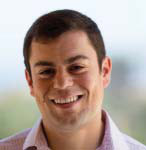Nano Aids Pharma In The Business Of Delivering Chemo
By Louis Garguilo, Chief Editor, Outsourced Pharma
 Michael Benchimol doesn’t want to compete with “conventional medicine.” At least not yet. The founder and chief technology officer of Sonrgy, Inc., a nanotechnology drug-delivery start-up based in San Diego, says, “Some in the pharma industry still view nanomedicine as competitive to their efforts. Instead, we are complementary to products they’re developing. Nano can build on existing therapeutics in completely orthogonal ways to open new doors for patients.”
Michael Benchimol doesn’t want to compete with “conventional medicine.” At least not yet. The founder and chief technology officer of Sonrgy, Inc., a nanotechnology drug-delivery start-up based in San Diego, says, “Some in the pharma industry still view nanomedicine as competitive to their efforts. Instead, we are complementary to products they’re developing. Nano can build on existing therapeutics in completely orthogonal ways to open new doors for patients.”
Orthogonal ways? “I’m referring to how nanomedicine can change the distribution of a drug without altering the chemistry of the compound,” he says. “This type of independent control over the kinetics of a drug is orthogonal. Basically, we leverage the great work pharma scientists have put into developing their compounds and build on that success for patients.”
Now leverage … I get. And as stated in a first article on nanomedicine in the September issue of Life Science Leader, we all should understand nano as a legitimate and growing segment of the biopharmaceutical sciences. Benchimol is optimistic: “More people are coming to realize the opportunity in taking a collaborative approach. Pharma is actively looking at enhancing their existing line of compounds and embracing nanomedicine as a part of that.”
Sonrgy is doing its part specifically by leveraging advanced ultrasound technologies to “burst” — or release — existing anticancer agents from nanocarriers (drug-loaded capsules 100 times smaller than our own blood cells) encapsulating these drugs. Simultaneously, Sonrgy utilizes the ultrasound’s advanced imaging to accurately monitor the treatment at the cancer tumors. Benchimol says the initial drugs Sonrgy is combining with its nanocarriers are well established generics known to be active against pancreatic and liver cancers, two of the most difficult-to-treat cancers in humans.
Here’s how Benchimol sees his business and technology — and the continued acceptance of nanomedicine — progressing over time.
NANO COMING TO THE DOCTOR’S OFFICE
With the advent of ADCs (antibody-drug conjugates) and various other delivery systems — including some nano-applications — for cytotoxic agents, we have reached a point in the history of medicine where technologies and products readily make use of the biochemical targeting of tumors. Sonrgy, however, takes a different tack. It’s decided not to employ biochemical targeting with the nanocarriers it has in development. “This allows the technology to work independently of a tumor’s biochemical profile,” explains Benchimol. The Sonrgy strategy is to use nanocarriers that remain circulating within patients for extended periods (and are composed of lipids), aided by ultrasound focused directly on tumors, “so the nanocarriers are releasing the drug payload directly into the tumor’s capillary bed … and not in other areas of the body where they can cause damage to healthy tissue.”
Benchimol, who holds a Ph.D. in ultrasound- responsive particles for cancer diagnostics and therapeutics and an MS in photonics, believes that in the near future, patients with these difficult-to- treat cancers will be able to lie on a bed in a doctor’s office or at a clinic and receive an infusion of the Sonrgy drug formulation (i.e., medicine inside nanocarriers) while receiving ultrasound. “It would be an outpatient procedure,” says Benchimol. “Similar to a typical chemotherapy regimen today, the treatment might be repeated to maximize efficacy so patients enter a more manageable disease state, including potentially downstaging patients so they can become candidates for surgery.” However, to be clear, before that scene plays out, more formulation development and technology design, ultrasound and nanocarrier enhancements, and of course clinical study, need to be accomplished. Here’s the business plan.

"Pharma is actively looking at enhancing their existing line of compounds and embracing nanomedicine as a part of that."
Michael Benchimol
Founder and CTO, Sonrgy, Inc.
ADVANCEMENT AND RECOGNITION
Sonrgy was formed in 2012 by Benchimol, his Ph.D.-advisor Sadik Esener, and another scientist at University of California San Diego, Chris Barback, who currently serves as Sonrgy’s head of Preclinical Ultrasound. Two years later, Brian O’Callaghan and David Renas were brought in to bolster the team. “I’ve worked exclusively in the technical and scientific field, and wanted to bring in business expertise to help navigate the field of pharmaceuticals,” says Benchimol. O’Callaghan has worked in a number of brand-name Big Pharma and smaller companies. Renas previously served as CFO and general counsel of Sangart, Inc., a biopharmaceutical company focused on the development of oxygen therapeutics.
Regarding the Sonrgy business model, like most start-ups nowadays, the company outsources as much as possible. However, it performs its own formulation testing and manufacturing — encapsulating the medicine into the nanocarriers — in its lab in Sorrento Valley, a tech/biotech hub in San Diego. And of course drug delivery companies like Sonrgy are natural partners for companies that own or discover new drugs. Sonrgy collaborates with Histogen, Inc., a biopharmaceutical company developing novel agents, to investigate the delivery of Histogen’s proprietary agents using Sonrgy technology. In this type of relationship, Sonrgy and its nanocarrier platform can enhance the performance of the agents, as well as potentially find ways of extending patent protection. And, as you would expect, Sonrgy is also working closely with a leading ultrasound device manufacturer to help develop and combine technologies. This provides Sonrgy the opportunity to test its material with an ultrasound system and interface already widely available at medical centers.
“For a long time people didn’t recognize the opportunity to precisely control the release of drugs externally,” says Benchimol. Those that did encountered challenges, including “a struggle to create a nanocarrier that remains stable long enough to hold onto its drug until it reaches the tumor location.” Benchimol believes his is the first technology to overcome this hurdle and also maintain all the necessary pharmacological properties proven necessary for a new drug. “It’s this combination of properties that sets us apart,” he says.
When I ask Benchimol about the promise of ADCs, his reply is similar to that of Laurent Levy, CEO of the Parisbased, oncology-focused nanomedicine company Nanobiotix, in the earlier article on nanomedicine I mentioned above. Their opinion is that nanotechnology will enhance the ADC platform. “ADCs are an exciting area; there have been successes, and there are more to come,” says Benchimol. “However, ADCs typically target specific subpopulations of patients who express a receptor to the antibody that they’re using to target. Basically, within a given indication, the products are limited to addressing those specific patients.” The nanotechnology Sonrgy is developing is not dependent on a patient falling into these specific subcategories. “As long as we have detected the tumor and know where it is, we can point the ultrasound at it and deliver more drug independent of what proteins the cells may express on their surface.”
A BIOTECH BY ANY OTHER NAME
Interestingly, Sonrgy calls itself a “preclinical biotechnology company” on its website. I ask Benchimol if that is more to avoid getting caught up in some of the pre-existing attitudes we mention above, and/or due to a lingering lack of larger recognition of nano as an important player in medicine. (How kind of me to provide him two negative choices.)
“Not really either,” he says. “We have no problem calling ourselves a nanomedicine company. In fact, more to the point, I think nano is clearly becoming a subset of the greater biotechnology industry. So in that regard, yes, we are trying to make ourselves understandable to the broadest audience.”
Sounds like a good strategy: Become one with the (perceived) opponent. Define yourself — correctly — as part of the solution to bring more and improved drugs and outcomes to patients. While I’m not qualified to know if this is an orthogonal application, it sure is another leveraging technique. And at the very beginning of this article we said Benchimol doesn’t yet feel like a competitor to “conventional medicine.” But if Sonrgy, and other nanomedicine companies on the rise, are successful, commercialization will have them going after some of the same markets as biotechs and pharma companies. In the spirit of this type of competition, and for the advancement of human health, let’s hope they get the recognition they deserve and are ultimately successful in their pursuit of nanomedicine.
